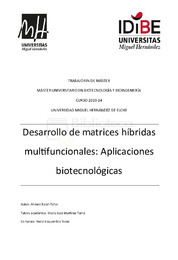Por favor, use este identificador para citar o enlazar este ítem:
https://hdl.handle.net/11000/33325Desarrollo de matrices híbridas multifuncionales: Aplicaciones biotecnológicas
| Título : Desarrollo de matrices híbridas multifuncionales: Aplicaciones biotecnológicas |
| Autor : Balah Tahiri, Ahmed |
| Tutor: Martínez Tomé, María José Esquembre Tomé, Rocío |
| Editor : Universidad Miguel Hernández de Elche |
| Departamento: Departamentos de la UMH::Agroquímica y Medio Ambiente |
| Fecha de publicación: 2024-09 |
| URI : https://hdl.handle.net/11000/33325 |
| Resumen : La calidad del agua es esencial para la salud humana y la de los ecosistemas. Los compuestos fenólicos representan uno de los mayores grupos de contaminantes entre los que se encuentran colorantes, fármacos y compuestos derivados de la fabricación de plásticos. Estos compuestos suelen ser poco biodegradables y por tanto tienen elevada persistencia. El uso de la enzima lacasa es una alternativa interesante para la biorremediación de aguas residuales debido a su amplio espectro oxidativo contra compuestos fenólicos y aromáticos. Sin embargo, hasta la fecha, el uso industrial de esta enzima no está muy extendido por su dificultad de reutilización y necesidad de calentamiento para obtener una catálisis efectiva. La inmovilización en matrices poliméricas podría ser una estrategia prometedora para contrarrestar alguna de estas limitaciones. Además, estudios recientes han señalado un efecto sinérgico entre nanoestructuras plasmónicas, como posibles soportes que permiten un control fototérmico de la actividad enzimática. En este Trabajo de Fin de Máster se han desarrollado materiales híbridos con capacidad fototérmica y catalítica. Se ha dotado al material de propiedades fototérmicas utilizando nanopartículas de oro (AuNPs), que fueron previamente sintetizadas y caracterizadas en disolución acuosa y en tampón, tanto desnudas como recubiertas con dos polímeros estabilizantes, uno catiónico y otro neutro. Para ello se han estudiado el tamaño y la carga con técnicas de dispersión de luz dinámica, la longitud de onda del plasmón y la respuesta térmica frente a la irradiación láser. Por su parte, la lacasa se ha utilizado como enzima modelo por sus propiedades catalíticas y fue caracterizada en disolución estudiando su estado conformacional y estabilidad térmica, así como la actividad catalítica. Ambos componentes se han inmovilizado y caracterizado sintetizando hidrogeles orgánicos poliméricos basados en acrilamida y matrices inorgánicas de sílice obtenidas mediante el proceso sol-gel. Los resultados muestran que la lacasa inmovilizada en hidrogeles y matrices sol-gel mantiene su estructura, aunque con cierta reducción en la actividad enzimática y estabilidad térmica frente a la enzima en disolución. Asimismo, las AuNPs recubiertas de PVP e inmovilizadas conservaron sus propiedades fototérmicas, incrementando significativamente la temperatura del medio bajo irradiación láser. Aunque es posible seguir optimizando la estabilidad y la actividad enzimática en las matrices 3D, este estudio sienta las bases para el desarrollo de matrices híbridas multifuncionales, habiendo conseguido la coinmovilización de ambas nanoestructuras en las matrices de sílice. Water quality is essential for human health and ecosystem stability. Phenolic compounds represent one of the largest groups of contaminants, including dyes, pharmaceuticals, and compounds derived from plastic manufacturing. These compounds are typically poorly biodegradable and, therefore, highly persistent. The use of the enzyme laccase offers an interesting alternative for the bioremediation of wastewater due to its broad oxidative spectrum against phenolic and aromatic compounds. However, to date, the industrial use of this enzyme is not widespread due to its difficulty in reuse and the need for heating to achieve effective catalysis. Immobilization in polymeric matrices could be a promising strategy to counteract some of these limitations. Additionally, recent studies have indicated a synergistic effect between plasmonic nanostructures, which can serve as potential supports that allow for photothermal control of enzymatic activity. In this Master's Thesis, hybrid materials with photothermal and catalytic capabilities have been developed. The materials were endowed with photothermal properties by utilizing gold nanoparticles (AuNPs), which were previously synthesized and characterized in aqueous solution and buffer, both uncoated and coated with two stabilizing polymers. The size and charge were studied using dynamic light scattering techniques, along with the plasmon wavelength and thermal response to laser irradiation. Laccase was used as a model enzyme for its catalytic properties and was characterized in solution by studying its conformational state, thermal stability, and catalytic activity. Both components were immobilized and characterized by synthesizing polymeric organic hydrogels based on acrylamide and inorganic silica matrices obtained through the sol-gel process. The results show that laccase immobilized in hydrogels and sol-gel matrices retains its structure, albeit with some reduction in enzymatic activity and thermal stability compared to the enzyme in solution. Additionally, PVP-coated AuNPs, once immobilized, maintained their photothermal properties, significantly increasing the medium's temperature under laser irradiation. While it is possible to further optimize enzymatic stability and activity within 3D matrices, this study lays the groundwork for the development of multifunctional hybrid matrices, having successfully co-immobilized both nanostructures in silica matrices. |
| Palabras clave/Materias: Lacasa nanopartículas de oro (AuNPs) hidrogeles sol-geles inmovilización caracterización |
| Área de conocimiento : CDU: Ciencias puras y naturales: Biología |
| Tipo de documento : info:eu-repo/semantics/masterThesis |
| Derechos de acceso: info:eu-repo/semantics/openAccess Attribution-NonCommercial-NoDerivatives 4.0 Internacional |
| Aparece en las colecciones: TFM-M.U en Biotecnología y Bioingeniería |
 La licencia se describe como: Atribución-NonComercial-NoDerivada 4.0 Internacional.
La licencia se describe como: Atribución-NonComercial-NoDerivada 4.0 Internacional.
.png)
